
There are three types of 802.11 frames: management, control, and data. Management frames are used to mange the BSS, control frames control access to the medium, and data frames contain payloads that are the layer 3-7 information. We will focus on the contents of each frame rather than understanding the context of the frame in the frame exchange process. Separate post to follow that will cover the various frame exchanges. As a consumer of all my own blog posts, I’ll be formatting this post in a way that it can be easily used as a reference and be as searchable as possible.
This post covers the information you will be expected to know for the CWNA-107 and CWAP-403 exams about frame types, formatting, and values. As you can see below, the level of knowledge expected for the CWNA exam is much simpler. In the CWAP exam, it is expected that you can identify the frame type, which information elements (IE) contain which values, and understand what each value represents.
CWNA-107 Objectives covered:
- 3.2 Identify and explain the basic frame types defined in the 802.11-2016 standard
- 3.2.1 General frame format
- 3.2.2 MAC addressing
- 3.2.3 Beacon frame
- 3.2.4 Association frames
- 3.2.5 Authentication frames
- 3.2.6 Data frames
- 3.2.7 Acknowledgement (ACK) frames
- 3.2.8 Block ACK frames
CWAP-403 Objectives covered:
- 4.2 Identify and use MAC information in captured data for analysis
- 4.2.1 Management, control, and data frames
- 4.2.2 MAC Frame Format
- Frame Control Field
- To DS and From DS
- Address Fields
- Frame Check Sequence (FCS)
- 4.2.3 802.11 Management Frame Formats
- Information Elements
- Authentication
- Association and Reassociation
- Beacon
- Probe Request and Probe Response
- 4.2.4 Data and QoS Data Frame Formats
- 4.2.5 802.11 Control Frame Formats
- Acknowledgement
- RTS/CTS
- Block Acknowledgement and related frames
- 4.3 Validate BSS configuration through protocol analysis
- 4.3.1 Country code
- 4.3.2 Minimum basic rate
- 4.3.3 Supported rates
- 4.3.4 Beacon intervals
- 4.3.5 WMM settings
- 4.3.6 RSN settings
- 4.3.7 HT and VHT operations
- 4.3.8 Channel width
- 4.3.9 Primary channel
- 4.3.10 Hidden or non-broadcast SSIDs
- 4.4 Identify and analyze CRC error frames and retransmitted frames
- 5.2 Analyze QoS configuration and operations
- 5.2.1 Verify QoS parameters in capture files
General Frame Format
802.11 frames consist of three major parts: header, body, and trailer. The CWNA objectives include an understanding of the general frame format. The CWAP exam is all about understanding each frame type, which fields are used, and what each information element (IE) contains information about. We’ll cover the basics for now.


Header
The frame header contains information about the where the frame is going, the data rate, cipher suite used to encrypt data frames, and more! It is important to understand each field in the header. The four address fields are source, destination, transmitter, and receiver. The header contents are different for each frame type; the image below shows that some fields may be 0 bytes when not in use or X bytes. For example, the header of an acknowledgement (ACK) frame only uses one of four address fields, the receiver address (RA). The other values found in the frame control field of the header that are frequently referenced include:
- DS Status – Indicates the directionality of the frame. Refer to the table below from the 802.11-2016 standard for the possible values and their meaning.
- More Fragments – if set to 1, the frame has been fragmented and has more fragments to transmit
- Retry – if set to 1, the previous attempt to transmit this frame failed.

The example below is from a QoS Data frame therefor it includes a QoS Control field as well.

Body
The body of an 802.11 frame contains the layer 3-7 information that is encapsulated and, hopefully, protected (encrypted) as well. The body of a frame varies in size depending on the transmission. For example, voice traffic frames will be smaller than a file download that will increase the TCP window based on the speed/reliability of the connection end-to-end.
Trailer
The trailer contains the frame check sequence (FCS). This is a 32-bit cyclic redundancy check (CRC) used to validate that the contents of the entire frame have not been tampered with or become corrupted while being transferred over the wireless medium. All values of the frame header and body are ran through a calculation; the result is held in the FCS field. If the receiver runs the frame through the same calculation but the result is not the same, the frame is corrupt/damaged. The receiver will discard the frame and not send an ACK frame. The sender knows to retransmit the frame because it did not receive acknowledgement. This is typically a result of high interference/collisions. Typically, the station that receives a bad CRC will discard the frame instead of forwarding it onto the operating system so you will not be able to see “bad” frames within protocol analyzers such as Wireshark.

Frame Types
All 802.11 frames fall under one of the three types: management, control, or data. The 802.11ac-2013 standard states that all data frames be sent as QoS data frames. In the header there is a frame control field that contains the values for type and subtype of the frame. The image below shows the three types of frames. Protocol version will always be 00 to indicate that 802.11 is in use. The type field indicates 0-management, 1-control, or 2-data. The subtype field indicates the type of management, control, or data frame. In our example here we see 8, 11, and 8 in the subtype fields. The management frame is a beacon, the control frame is a request-to-send (RTS), and the data frame is a QoS Data frame.
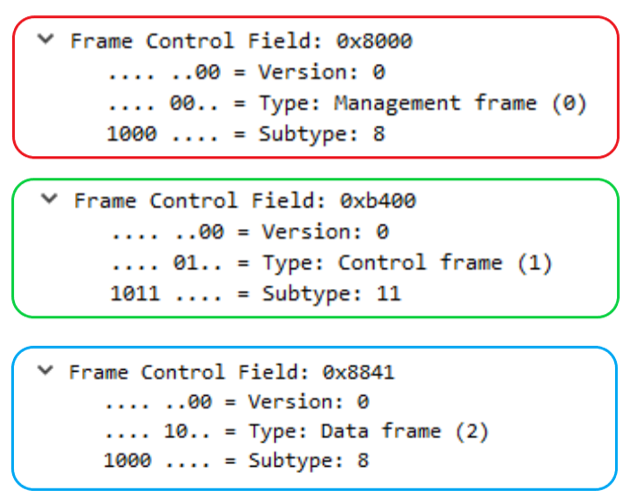
Management Frames
Management frames are used to manage the BSS. This includes probing, associating, roaming, and disconnecting clients from the BSS. As shown above, management frames use a type of 0 in the frame control field within the frame header.
| Subtype Field | Description |
| 0000 | Association request |
| 0010 | Reassociation request |
| 0100 | Probe request |
| 0110 | Timing advertisement |
| 1000 | Beacon |
| 1010 | Disassociation |
| 1100 | Deauthentication |
| 1011 | Authentication |
| 1110 | Action |
| 0001 | Association response |
| 0011 | Reassociation response |
| 0101 | Probe response |
| 0111 | Reserved |
Association Request/Response
Stations send association requests to access points (APs) requesting to join the BSS. In this frame, the station sends all its capabilities to the AP; it will only include capabilities that the AP has also advertised in the beacon or probe response frame. The AP responds to the station using an association response frame that includes an association ID (AID). Each station within the BSS has a unique AID.
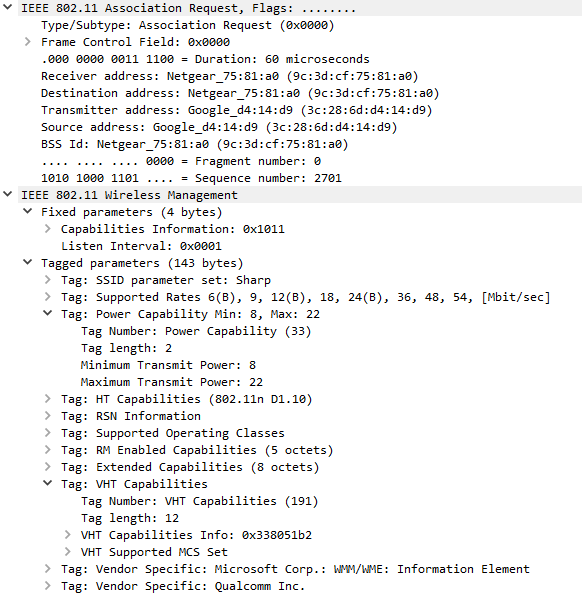
Reassociation Request/Response
Stations send reassociation requests to APs that wish to roam to. The AP responds to the station the same way it does in the association request/response. The primary difference between reassociation and association requests is that the station will indicate the current AP it is connected to in reassociation requests. If the station does not receive a reassociation response for reasons such as load balancing, it will remain connected to the original AP and search for other APs to roam to. There are also cases where, after leaving a BSS for a short period of time, a station will send a reassociation request to an AP it was recently connected to.

Probe Request/Response
As part of the active ad passive scanning processes, stations send probe requests with a specific SSID, wildcard, or no value (null) in the “SSID Parameter Set” field to search for wireless networks. When the field is wildcard/null, the client is requesting any AP nearby to respond with all SSIDs using a probe response frame. When the probe request contains a specific SSID, the client is requesting any AP nearby to respond if they support that SSID. The probe response frame is a targeted beacon that is sent to the station who is “probing”. As you can see below, the probe response frame contains all but 3 of the same fields as beacon frames. The three differences are: the probe response frame does not contain a TIM, a QoS capabilities information element, and any information elements requested by the station. Be sure to understand the differences between active and passive scanning for both exams.


Beacon
APs send beacons at a regular interval called the target beacon transmit time (TBTT) to advertise the SSIDs they service. Beacons contain the configuration of the WLAN including whether it supports standards such as 802.11k, 802.11r, the required cipher suites and authentication key management (AKM) methods, whether protection mechanisms are required, etc. The presence of certain information elements (IE) indicate whether the related configuration is present. The figure below shows which fields are mandatory in a beacon frame. Note that this information is in the body of the management frame.

Below shows a beacon frame in Wireshark. We can see a timestamp of 316618342401 which is used to keep time synchronized among stations in a BSS. Our beacon interval, also known as target beacon transmit time (TBTT) is the default of 102.4ms. The required “Capability Info” field is expanded below. The SSID being advertised by the beacon is “Taynouse” and supported data rates are listed following. It is important to capture your own beacons and start poking around; the number of optional fields is much longer than the required fields. It is important to know the names and purpose of all the beacon fields for the CWAP exam. I highly recommend downloading a copy of the 802.11-2016 standard for free here and searching for each of these fields yourself.


The CWAP objectives state that you should be able to determine the configuration of a BSS from looking at a decoded BSS frame. I have highlighted the areas of importance below.

Authentication
Authentication frames are used to join the BSS as part of the open system authentication process. Open system authentication is a simple process used to verify that the station attempting to join the BSS has the capabilities to do so. The station sends an authentication request and the AP sends an authentication response. The body of the authentication frame includes the algorithm number, transaction sequence number, and status code. With open system authentication, the authentication algorithm number is 0. The sequence number will either be 1 or 2 to indicate which frame of the two-frame transaction you are viewing. The authentication response frame is always sequence number 2 and will include a status code indicating success or fail.


The PCAP below shows deauthentication, disassociation, reassociation, authentication, and the 4-way handshake!
Disassociation
A type of management frame sent from either the station or the AP. Disassociation frames are used to terminate the station’s association; it is a notification and does not expect a response. Clients may disassociate prior to powering off. APs may disassociate clients for various reasons including failure to properly authenticate, for load balancing or timeout reasons, entering a state of maintenance, etc. The 802.11-2016 standard includes a list of disassociation reasons. When a station is disassociated it still maintains its authentication. This makes it easier for the client to associate again in the future. The table below is part of table 9-45 showing reason codes for disassociation from the 802.11-2016 standard.

In the example below, we can see reason code 8 (LEAVING_NETWORK_DISASSOC): Disassociated because sending STA is leaving (or has left) BSS.

Deauthentication
Deauthentication frames are used to reset the state machine for an associated client. The authentication process takes place prior to association therefor, if a station is deauthenticated, it is also disassociated. Deauthentication frames also include a reason code in the body of the frame from the table mentioned above. Know that deauthenticating a client resets their process in the 802.11 state machine back to step 1.

Action
Action frames are management frames that trigger an action to happen. The list of management frame subtypes had become exhausted, so instead of creating new management frames as new technologies required them, the action frame can be used. Action frames do not expect an ACK. They were first introduced in the 802.11h-2003 standard which also introduced transmit power control (TPC) and dynamic frequency selection (DFS). The 802.11-2016 standard includes action frames for many categories such as spectrum management, QoS, HT, VHT, radio measurements, and many more. The table below from 9.6.2.1 of the 802.11-2016 standard shows the spectrum management action frames.

Below we can see the action frame type of “Action No Ack” and an example frame used to communicate a compressed beamforming report.


This action frame is an “add block ack response” (ADDBA) action frame. It is used to setup the block ack policy for the exchange of blocks of QoS data frames.
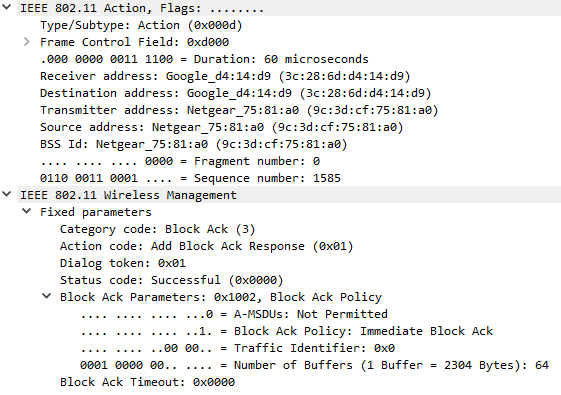
Timing Advertisement
Timing advertisement frames were introduced in 802.11p-2010; this standard describes how Wi-Fi can be used in vehicular environments. This type of management frame is not in use today and is expected to be used to communicate time values to devices that cannot maintain their own timing.
Control Frames
Control frames are used to control access to the medium and are used for frame acknowledgement. Control frames only contain a header and trailer, no body. The control frame types bolded in the table below are only used in point coordination function (PCF) based wireless networks. These were never implemented in the real world.
| Subtype Field | Description |
| 0100 | Beamforming Report Poll |
| 0101 | VHT/HE NDP Announcement |
| 0110 | Control Frame Extension |
| 0111 | Control wrapper |
| 1000 | Block ACK Request |
| 1001 | Block ACK |
| 1010 | PS-Poll |
| 1011 | RTS |
| 1100 | CTS |
| 1101 | ACK |
| 1110 | CF-End |
| 1111 | CF-END+CF-ACK |
Request to Send – RTS
Stations send RTS frames to reserve the medium for the amount of time, in microseconds, found in the duration field in the frame header. RTS and CTS frames are very simple. The medium will not be reserved for the station until it receives a clear to send frame response from the access point. I explain the RTS/CTS process in detail in my Wireless Contention Mechanisms post. RTS/CTS are used as a NAV distribution method as part of the virtual carrier sense process.


Clear to Send – CTS
Frame sent by an AP in response to an RTS frame sent by a station. CTS messages are sent at the lowest mandatory data rate, allowing them to reach all stations in the BSS. They only use the receiver address (RA) field in the header. The station in the receiver address field is the one that will be transmitting frames.



Acknowledgement – ACK
ACK frames create a delivery verification method; they are expected after the transmission of data frames to confirm receipt of the frame. If the CRC check fails, the receiver will not send an ACK. If the sender does not receive an ACK, it will retransmit the frame.
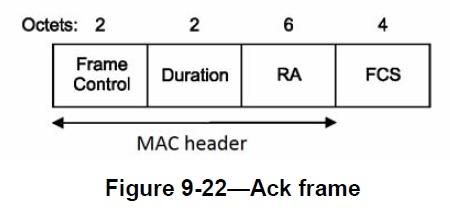

PS-Poll
PS-Poll frames are used in the legacy 802.11-1997 power save method to request frames buffered on the AP while the client was sleeping. Clients include their AID in the Duration/ID field when sending PS-Poll frames. The process is covered in greater detail in my Power Save Methods post.

Block ACK / Block ACK Request
Introduced in 802.11e-2005, block acknowledgements are used to confirm receipt of a block of QoS data frames. A station will send multiple QoS data frames followed by a block ack request (BAR). The AP will send a block ack frame back that includes a bitmap that indicates which frames were received. With this method, only the frames indicated by the bitmap that weren’t received are retransmitted. This increases the overall network efficiency by reducing the amount of ACK frames that need to be sent.

The block ack below shows a BA Ack Policy of 0 meaning immediate acknowledgement of the transmitted frames is required.



Beamforming Report Poll
Beamforming report poll frames are sent from the beamformer (the AP) to beamformees (STAs) to request additional feedback about the RF conditions. This frame is sent to the second and subsequent beamformees; it allows the AP to update its steering matrix for sending in MU-MIMO environments.

VHT/HE NDP Announcement
Null data packet (NDP) announcement frames notify the recipient that an NDP will follow. The figure below shows the frame exchange process. The beamformer (AP) will request that the station send an NDP sounding frame by setting the training request (TRQ) value in the Link Adaption Control subfield of the HT Control Field. The information gathered from the sounding frame can be used to calculate a steering matrix for the purpose of using beamforming for future transmissions to the same station.

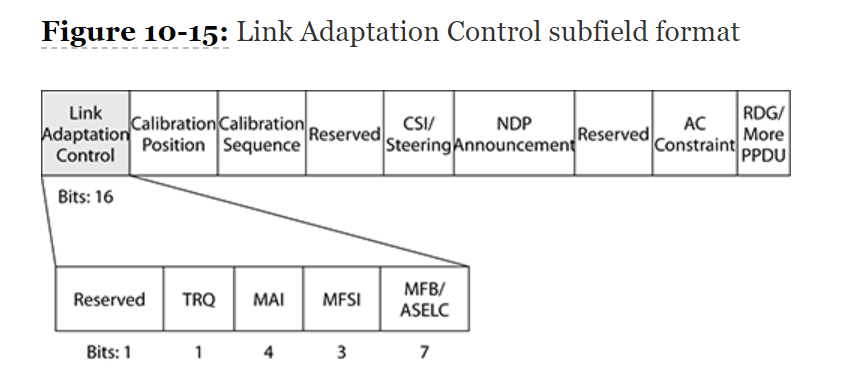


Control Wrapper
Per the IEEE 802.11-2016 standard, the control wrapper control frame is used to add the HT control field to other control frames. This is accomplished by “wrapping” (or encapsulating) the original control frame, minus duration/ID, Address 1, and the FCS, in a control wrapper frame. We can see below a “Carried Frame Control” value that indicates the subtype value of the control frame being carried. This is how 802.11n HT capability information is added to control frames.

Control Frame Extension
Added in 802.11ad – Directional Multigigabit (DMG), which defines the use of Wi-Fi in the 60GHz frequency range, control frame extension frames reuse 4 bits of the frame control field (B8-B11) for additional control frames that are used with DMG. The list of additional control frames for DMG can be found in the table below from the 802.11-2016 standard.

Data Frames
Data frames are used to transfer information or trigger an event. Not all data frames contain a payload, some are “null data frames” and only contain a header and trailer. The data frame types bolded in the table below are only used in HCF controlled channel access (HCCA) or point coordination function (PCF) based wireless networks. These were never implemented in the real world. This leaves only 4 to pay attention to.
| Subtype Field | Description |
| 0000 | Data |
| 0001 | Data + CF-ACK |
| 0010 | Data + CF-Poll |
| 0011 | Data + CF-ACK + CF-Poll |
| 0100 | Null (no data) |
| 0101 | CF-ACK (no data) |
| 0110 | CF-Poll (no data) |
| 0111 | CF-ACK + CF-Poll (no data) |
| 1000 | QoS Data |
| 1001 | QoS Data + CF-ACK |
| 1010 | QoS Data + CF-Poll |
| 1011 | QoS Data + CF-ACK + CF-Poll |
| 1100 | QoS Null (no data) |
| 1101 | Reserved |
| 1110 | QoS CF-Poll (no data) |
| 1111 | QoS CF-ACK + CF-Poll (no data) |
Data
Used when communicating to a non-QoS station. Broadcast/Multicast traffic is typically sent as a simple data frame unless the station knows that all stations within the BSS are QoS capable.

QoS Data
Used when a QoS station transmits to another QoS station. The header in QoS data frames contains a QoS control field that will indicate the access category (AC), policy type, and payload type.

Null Data / QoS Null Data
Used to transmit control information without carrying any data. Some stations may use null data frames to indicate that they are entering power save mode or that they are waking up.

Example PCAP
Attached is a PCAP file that you can use to apply filters to view the frames for yourself to better understand the frame format and values. The frames that can be found include: association request/response, authentication request/response, probe request/response, 4-way handshake, RTS/CTS, QoS and simple data frames, and more! It also includes captures of the data frames for inspection of layer 3-7.

Basic information:
SSID: HowIWiFi
PSK: CWAPnotes123
STA: 00:20:A6:FC:B0:36
AP: 2C:F8:9B:DD:06:A0
To decrypt the data frames in this capture, open preferences, select IEEE 802.11, select “Edit…” next to Decryption keys, and enter the PSK and SSID as shown below.

Below is a list of filters you can apply and the types of frames or frame exchange that will be shown.
| Filter | Frames |
| frame.number >= 9250 && frame.number <=9274 | Disassociation, Deauthentication, Authentication, Association Request/Response, 4-way handshake (EAPOL), ACKs |
| frame.number == 4505 || frame.number == 4507 | Station using action frame to request 802.11k neighbor report and AP responding with report. |
| (wlan.fc.pwrmgt == 1) && (wlan.fc.type_subtype == 0x0024) | Station using null data frame to notify the AP that it is going to sleep. |
| wlan.fc.type_subtype == 0x000a | Station sends disassociation frame to AP with “STA is leaving BSS” reason code. AP sends disassociation frame to STA with “Unknown” reason code. |
| wlan.fc.retry == 1 | Shows number of times a frame had to be retransmitted. 2.4% of frames in capture. |
| wlan.fc.type_subtype == 0x000c | AP sends deauthentication frames to STA with reason codes “Unknown” and “Class 3 frame received from nonassociated STA” meaning that the STA transmitted frames prior to association. |
| wlan.fc.type_subtype == 0x0005 || wlan.fc.type_subtype == 0x0004 | Shows all probe requests and probe responses. |
| frame.number >= 15946 && frame.number <= 15949 | AP sends RTS to STA, AP sends CTS with RA as itself to indicate that it is clear to transmit frames, AP sends QoS data frame to STA, and STA sends a Block ACK to confirm receipt. |
Conclusion

It is very satisfying once you understand how to perform the detective work to troubleshoot a wireless issue that requires protocol analysis. The sheer number of frames and their unique elements may seem overwhelming when studying for the CWAP exam; especially the frames that only show up every so often and aren’t obvious in their intent, such as action and null data frames. Practice makes perfect. Real-world experience with over-the-air packet captures and performing protocol analysis goes a long way. For some of the more complex processes, such as NDP sounding, I found it best to focus on the basics. Many of these frame types have multiple levels of understanding. A The next step is to understand the frame exchanges in which these frames are used.
I hope these short explanations, visuals, and attached PCAPs help you better understand the purpose of each frame type by showing the format and a decoded frame within Wireshark. I don’t believe there is such thing as “too much practice” for the CWAP exam, perform as many packet captures as you can and try to picture the stations communicating with the AP.
References
IEEE 802.11-2016 Standard
Hello There,
Excellent work, will be up on my office wall, monday.
I am (still) studying for a CWNA, this will help me a lot.
Many thanks
Tony
PS, now to ‘rummage’ around your site …… good use of a Saturday night, in my book.
LikeLike
Thanks Anthony! Glad I am able to help you achieve your certification goals!
LikeLike
Excellent work. quick one, you mentioned that If the sender does not receive an ACK, it will retransmit the frame, what about the BlockAck, if it’s corrupted and not received by the receiver, what frame will be retransmitted?
LikeLike
Thank you very very much! There is lack information about this topic in the internet. Your post is very useful.
Could you explain how to determine where is access point and where is associated clients in *cap file. Should I use “data” frame type to filter? Or “management” frame type contains this information too?
LikeLike
That’s amazing this post have amazing informations about the wireless part that’s great for CCNA and also CCNP studying and of course for understand how wireless is working.
Pretty intresting!
LikeLike